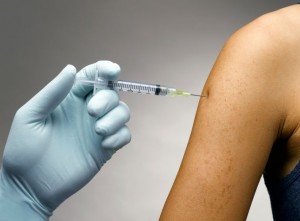I’ve recently had several people ask me how my shoulder is doing since getting my flu shot at the beginning of January. It’s now flu shot season, and judging by traffic to this site, others have also been wondering if the shoulder pain they’re experiencing after their shot is typical or not. So I wanted to provide an update on it.
Is my shoulder better now?
Yes. And no.
Back in February, a month after my flu shot, I saw an orthopedic specialist who diagnosed me with subacromial bursitis. I was given a cortisone shot directly into the joint to help with the pain and stiffness, and handed an order for physical therapy. The cortisone shot was like a miracle – my shoulder was more sore the day the shot was given, but by day three the pain was nearly gone. I still had some stiffness and ache if I moved my shoulder to the upper limits of a stretch, but otherwise I felt great.
I set up my physical therapy and completed six weeks of appointments, twice a week. The goal was to strengthen and stretch the muscles around that joint for better movement and (hopefully) no more pain.
By April, I thought that perhaps I was all in the clear. The pain was gone, and other than some “popping” in my shoulder for certain movements, it seemed completely normal.
Then in mid-June, I went to Chicago for a one-day trip: one plane ride there, half a day in a conference, and then a few hours wait in the airport before another plane ride home. While waiting for my flight home, I noticed that my shoulder felt a little sore. I had been carrying my bag on that shoulder for part of the day, so I assumed that the soreness was just muscle soreness from carrying the bag during a very busy day. My back was sore from uncomfortable seats on the plane, too, so I didn’t worry.
But then a week later I noticed that shoulder in particular was still a little sore with certain movements. Shouldn’t it have been better by now? I took some ibuprofen for the next week, restarted the exercises I was taught in physical therapy, and hoped it was just a small flare up that would go away.
I finally admitted this low-level, chronic ache wasn’t going away at the start of August (yes, AUGUST – I’m stubborn like that), and scheduled an appointment with the orthopedic specialist again. He took a look and said the range of motion was still better than it had been, but wanted to make sure there wasn’t anything else going on. X-rays were taken, and nothing could be seen from them, so he ordered an MRI.
The MRI thankfully showed no damage to the rotator cuff tendons. So, ruling out any other issues, we were right back to the original diagnosis – subacromial bursitis. He told me that the cortisone shot probably did a great job at keeping the inflammation in check, but that it eventually wears off for most people. It’s likely that the cortisone shot I received in February lost its effectiveness in June, allowing the inflammation caused by my improperly placed flu shot to come back.
My doctor suggested another cortisone shot, since the first one did help. When he was injecting the cortisone, the doctor said bursitis was definitely the diagnosis, as the joint capsule was very tight and he had to apply more pressure than usual to get the cortisone into the space.
For now, my shoulder feels fine. I have full range of movement, I can sleep on that side, and while I’m still a little weaker on the left, I can perform weight-bearing exercises on that side. The first cortisone shot did eventually wear off, but my shoulder was still in a better state at that point than it was before the first cortisone injection was given. My hope is that the second cortisone shot finishes the job and allows the joint to completely heal.
But the truth is, I don’t know for sure. It’s possible the cortisone will wear off again and I’ll be right back in my doctor’s office. It’s definitely a possibility. There was talk of surgery to essentially “clean out” the joint as a last resort – I’d like to avoid that if I can. Surgery is simply not something I even want to think about right now.
I’m still frustrated that I had to go through all of this due to a flu shot. SIRVA (Shoulder Injury Related to Vaccine Administration) is a serious issue, and while it only affects a small percentage of people, it’s entirely preventable by ensuring good form when giving an injection.
I still stand by the tips I provided in my first post about this. If the placement seems wrong, say something. Make sure the person giving the shot is at the same level as you. Consider carefully who will be giving the shot. And if you’re eligible for it, consider the Flumist instead.
 This is a good spot for an injection. Not higher.
This is a good spot for an injection. Not higher.
A stiff or painful shoulder after a flu shot can be completely normal. The pain is usually at its worst the day of and the immediate day after, fading quickly after that, and it’s felt in the muscle. If the pain gets worse on day two or day three, doesn’t start to decrease by day four, and is causing you to restrict your range of motion with that shoulder, it’s worth giving your doctor a call to get it looked at.
There’s a big push for everyone to get their flu shots at this time of year. I haven’t received mine yet, and I’ll admit to being a little more cautious about having it done this time. I’ll likely either choose the Flumist nasal vaccine, or let the nurse in my family doctor’s office give the shot, as I trust her to do it properly.
I won’t tell you that you must have a flu vaccine or that you should avoid them completely – that’s an individual decision for all of us. But I would urge you to pay attention if you do get one, and don’t be afraid to ask questions. It’s your health, and you have the right to make sure your vaccine is being given properly.
Note: a quick Google search helped me find this recent article for nurses, which specifically mentions techniques to avoid shoulder injury. It’s good to see the medical community taking more notice of this topic.








